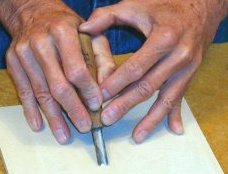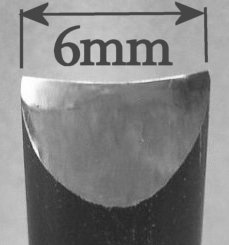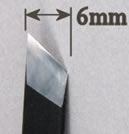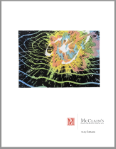
Futatsu Wari Moku Hanga To - from bottom to top:
Hangi To (knife),
Sankaku To (v-gouge),
Komasuki (u-gouge),
Aisuki (bull-nose chisel).
Some tools will come with a silver color plated brass ferrule instead of the brass one seen in the photos.
These tools are designed specifically for hand carving wood blocks. They are the tools that have been used by professional carvers in Japan for centuries. Tools of this quality cannot be mass produced. Each knife is a unique, handcrafted work of art, a fine tool to be used and enjoyed for a lifetime.
The blades on all of these tools can be repositioned or replaced.
 |
Komasuki, Aisuki and Sankaku To blades are carefully fitted into the handle and held in place by a hook at the end opposite the tip. Slip off the ferrule and the two-part handle swings open like a fan. |
 |
The hangi to has a one-piece handle and its blade can also be removed by slipping off the ferrule. |
The short length of the komasuki, sankaku to, or aisuki allows them to be placed at the intersection of the thumb and the index finger, not in the palm as with Western knives, and controlled with the fingers of the free hand.

(This photo was taken holding a Josei Maru To but the hand positions are basically the same.) This position takes some getting used to, but it gives better control and the muscles in the hand are relaxed compared to holding the tool in a tight fist so they do not tire as easily. Don't give up until you learn this technique!
The hangi to may be held in several ways depending on the cut being made. Sometimes it is gripped with the whole hand, thumb pushing down on the handle's end, with the free hand guiding it in the cut. At other times, the hangi to is held like a pencil, with the free hand pushing or pulling it along.


The blade sizes of the sankaku to and komasuki are based on measuring across of the top of the V or U from one side to the other. The sizes of the hangi to and aisuki are found by measuring the blade horizontally from side to side. Measurements are given in millimeters because this is how the tools are measured in Japan and it is more precise than inches. A conversion table can be found at www.tech-faq.com/mm-to-inches.html
All of the tools are about 5" (12.5cm) in length. The handles are kaba (birch) and individually fitted to each blade.

